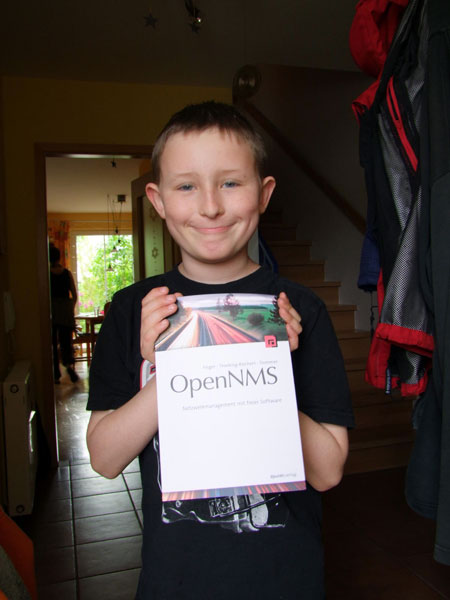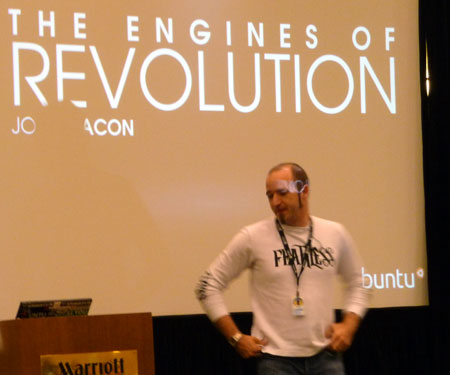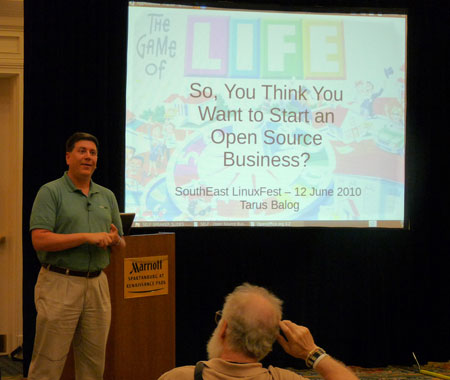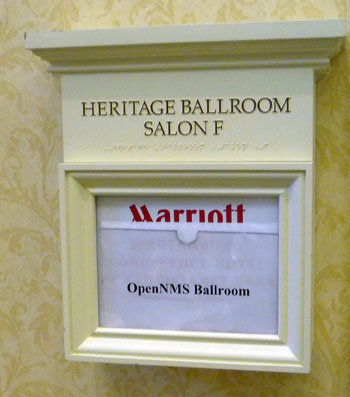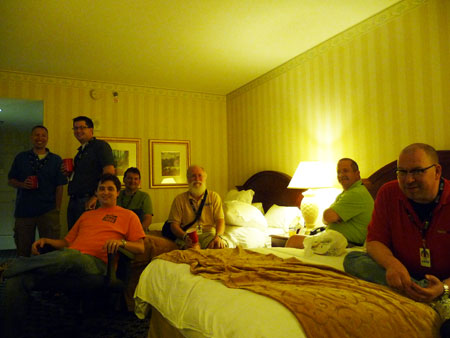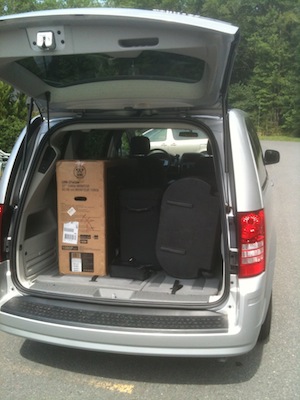[Note: Ben has been writing these for some time now, but I figured it is worth highlighting them on the blog, too. They can always be found in the News section of opennms.com]
It’s time for This Week in OpenNMS. In the last week, we did some more work in preparation for 1.8.1, worked a bit more on the iPhone/iPad app, and did a huge amount of bugfixing.
Project Updates
- 1.8: Current Release is 1.8.0
1.8.0 is the current stable release, tagged June 7th. The first major stable release in the 1.8 series, it adds a whole slew of new features compared to 1.6. For a high-level overview, see the “New and Noteworthy” page on the OpenNMS wiki. While we consider this release to be stable, a ton has changed. It is recommended that you back up your database, and test an upgrade on non-production hardware before moving to 1.8 in production. - 1.8: Inline Thresholding Regression
Inline thresholding was enabled in the default configs late in the 1.6 series, but it was never enabled by default in the 1.7 branch, so 1.8.0 was released without inline thresholding enabled. This was changed with the fixing of bug #3912, so be aware when merging configs when 1.8.1 comes out! - 1.8: Remote Poller Maps Updates
Matt, Donald, and I did a bunch of work on the remote poller maps, doing a huge amount of optimization of the queries used to pull poller data into the UI, adding support for Mapquest’s click and double-click behaviour (center, and center+zoom), and adding support for multiple map types in the OpenLayers implementation.
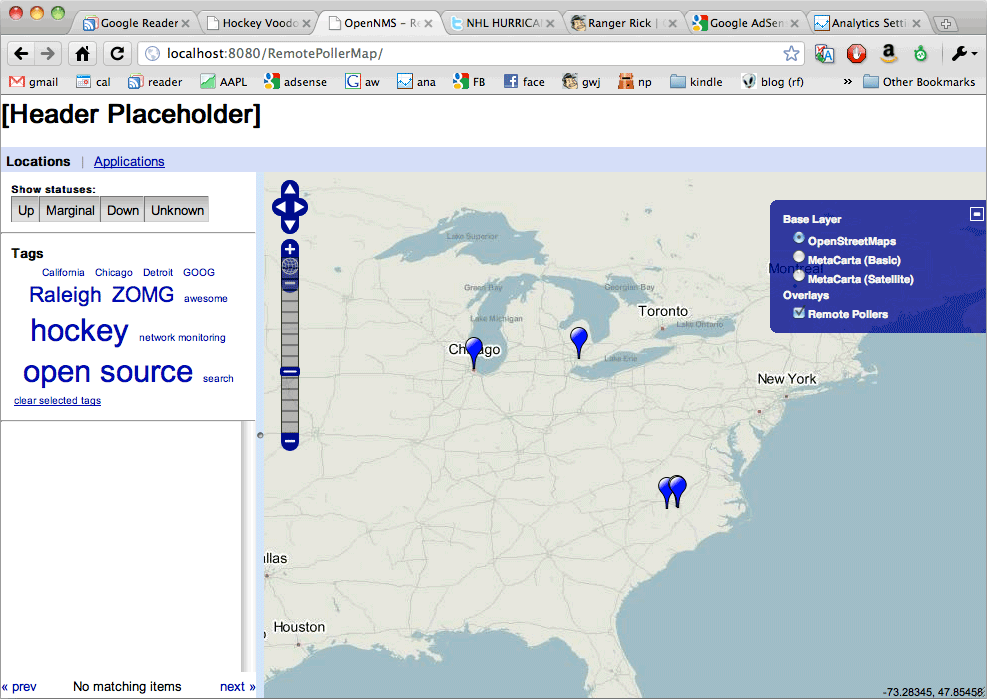
- 1.8: Tons of Bug Fixes
I did a bunch of work going through Bugzilla this week, trying to close out bugs in preparation for 1.8.1, which will go into code slush next monday, and be released on the 12th.
Bugs Fixed Since Last TWiO
- #1181: Collectin Windows disk space, trying to poll the CD drive
- #1920: javamail using authentication encodes the username and password twice
- #1959: Too many calls to getlocahost()
- #2922: PSQLException in poller backend: DB field length exceeded on remote location monitor status update
- #2944: java.lang.NullPointerException on KSC Graphs
- #3124: HttpMonitor doesn’t check JSON repsonses for response-text
- #3192: New Feature: allow syslogd to bind to specific ipaddress
- #3280: Equallogic iSCSI array performance data
- #3283: Reparenting of iLO interface on HP servers not working with ESX4
- #3291: provisiond : snmpinterfaces not created
- #3296: running the installer without the database running throws an exception about “The database server’s error messages are not in English”
- #3306: 1.7.svn (fresh today) does not show service, availability on node page
- #3514: default datacollection-config.xml breaks alias length limit
- #3536: Unable to use the “percent sign (%)” in a notification text message
- #3576: Fix send-event.pl script to encode time in DateFormat.LONG
- #3578: Incorrect http content-type header for svg request
- #3589: Advanced Alarm Search some of the Sort by options don’t work properly
- #3598: An Exception occurs when you try to create a surveillance category that already exists.
- #3622: Bugs with Hyperic servlets
- #3624: Rename from Import to Synch(cronize) in Prov Groups
- #3632: admin role is negated for users also in readonly role
- #3637: JasperException PWC6033
- #3644: trying to add list of ip range to discover
- #3656: mib2opennms does not install in Debian Lenny
- #3675: Events missing page counter
- #3722: Debian Packages: opennms-contrib missing dependency for libxml-twig-perl
- #3847: Page Sequence Monitor still submitting multiple ‘Cookie:’ response headers even with BROWSER_COMPATIBILITY is enabled
- #3869: Data Collection Failed Event (dataCollectionFailed) not informative
- #3871: linkd not showing links between nodes and cisco switches
- #3899: Patch: allow per node filtering in notifications list
- #3900: dashboard user has security issues
- #3901: add support for click/double-click handlers
- #3910: Patch: display First Next Previous links in events list at the bottom of the page
- #3912: inline thresholding is no longer enabled by default
- #3915: regular expression “pattern”s in XSDs are not evaluated
- #3923: Stale location specific status change events should be deleted
- #3924: NPE handled too gracefully by MailAckProcessor in Ackd
Goof-Up of the Week
Jeff relayed this tale of the importance of having priorities in scrum this morning… 🙂
I spent last week helping a telecoms industry client implement OpenNMS. Toward the end of the second day we decided to switch from Capsd discovery to Provisiond requisitions, so I wrote a small script that
reads an inventory dump from their old NMS (CA Spectrum) and creates an OpenNMS requisition describing the same nodes. The database was full of junk events from before we’d put in place some new SNMP trap definitions, so I went about removing all that stuff manually before importing the new requisition. Several folks were going out for a beverage and invited me along, so I hurried in order not to hold them
up. The next morning there were over 600 nodes in the system instead of the 391 I was expecting. I double-checked that Capsd was turned off, that Provisiond was not handling newSuspect events, and that there were in fact no such events in the database, then contacted the development team about my suspicion of a bug. After nearly an hour, the client mentioned that he was seeing some duplicate nodes that didn’t have any events, alarms, or notifications associated with them. Only then did it dawn on me that, in my haste to get my hands on some suds, I had forgotten to delete the old nodes themselves before importing the new requisition!
Upcoming Events
- July 7th-9th, 2010: Ben will be speaking at OpenStreetMaps’ State of the Map 2010, in Girona, Spain.
- July 21st, 2010: Tarus will be giving his “So, You Think You Want to Start an Open Source Business?” talk at OSCON
- July 26th-30th, 2010: OpenNMS Dev-Jam 2010 will be held at the University of Minnesota in Minneapolis, MN
If you have anything to add to the events list, please let me know.
Until Next Week…
As always, if there’s anything you’d like me to talk about in a future TWiO, or you just have a comment, criticism, or blocking bug closing machines that you’d like to share, don’t hesitate to say hi.
